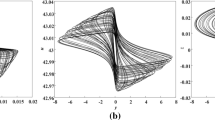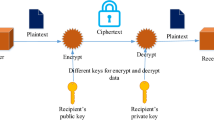Abstract
In this paper, a secured watermarking algorithm based on chaotic embedding of speech signal in discrete wavelet transform (DWT) domain of cover audio is proposed. The speech signal to be embedded is compressed using discrete cosine transform (DCT) by finding the suitable number of DCT coefficients such that the perceptual quality of decompressed signal is preserved. The chaotic map is used to select the cover audio frames randomly instead of performing sequential embedding. The cover audio is decomposed using DWT followed by singular value decomposition (SVD), and the DCT coefficients of the speech signal are embedded in the singular matrix of the cover audio. The proposed watermarking algorithm achieves good imperceptibility with an average SNR and ODG of 46 dB and \(-1.07\), respectively. The proposed algorithm can resist to various signal processing attacks such as noise addition, low-pass filtering, requantization, resampling, amplitude scaling, and MP3 compression. Experimental results show that the secret speech is reconstructed with an average perceptual evaluation of speech quality (PESQ) score of 4.26 under no attack condition, and above 3.0 under various signal processing attacks. Further, the correlation between original and reconstructed secret speech signal is close to unity. In addition, the loss in the generality of the information of the reconstructed speech signal is tested and is found minimum even the watermarked audio is subjected to various signal processing attacks. The proposed algorithm is also tested for false positive test to ensure the security of watermarking algorithm.












Similar content being viewed by others
References
Sathiyamurthi, P.; Ramakrishnan, S.: Speech encryption using chaotic shift keying for secured speech communication. EURASIP J. Audio Speech Music Process. 1, 20 (2017). https://doi.org/10.1186/s13636-017-0118-0
Lakshmi, C.; Ravi, V.M.; Thenmozhi, K.; Rayappan, J.B.B.; Amirtharajan, R.: Con (dif) fused voice to convey secret: a dual-domain approach. Multimed. Syst. 26, 1–11 (2020)
Ehdaie, M.; Eghlidos, T.; Aref, M.R.: A novel secret sharing scheme from audio perspective. In: 2008 International Symposium on Telecommunications, IEEE, pp. 13–18 (2008)
Wang, J.Z.; Wu, T.X.; Sun, T.Y.: An audio secret sharing system based on fractal encoding. In: 2015 International Carnahan Conference on Security Technology (ICCST), IEEE, pp. 211–216 (2015)
Bharti, S.S.; Gupta, M.; Agarwal, S.: A novel approach for verifiable \((n, n)\) audio secret sharing scheme. Multimed. Tools Appl. 77(19), 25629–25657 (2018). https://doi.org/10.1007/s11042-018-5810-2
Djebbar, F.; Ayad, B.; Meraim, K.A.; Hamam, H.: Comparative study of digital audio steganography techniques. EURASIP J. Audio Speech Music Process. 1, 25 (2012)
Hua, G.; Huang, J.; Shi, Y.Q.; Goh, J.; Thing, V.L.: Twenty years of digital audio watermarking—a comprehensive review. Signal Process. 128, 222–242 (2016)
Mishra, S.; Yadav, V.K.; Trivedi, M.C.; Shrimali, T.: Audio steganography techniques: a survey. In: Advances in Computer and Computational Sciences, pp. 581–589. Springer, Berlin (2018)
Xu, T.; Yang, Z.; Shao, X.: Novel speech secure communication system based on information hiding and compressed sensing. In: 2009 Fourth International Conference on Systems and Networks Communications, IEEE, pp. 201–206 (2009). https://doi.org/10.1109/ICSNC.2009.71
Shahadi, H.I.; Jidin, R.; Way, W.H.: Lossless audio steganography based on lifting wavelet transform and dynamic stego key. Indian J. Sci. Technol. 7(3), 323 (2014)
Ballesteros, L.D.M.; Moreno, A.J.M.: Highly transparent steganography model of speech signals using efficient wavelet masking. Expert Syst. Appl. 39(10), 9141–9149 (2012). https://doi.org/10.1016/j.eswa.2012.02.066
Ali, A.H.; George, L.E.; Zaidan, A.; Mokhtar, M.R.: High capacity, transparent and secure audio steganography model based on fractal coding and chaotic map in temporal domain. Multimed. Tools Appl. 77(23), 31487–31516 (2018). https://doi.org/10.1007/s11042-018-6213-0
Ballesteros, D.M.; Renza, D.: Secure speech content based on scrambling and adaptive hiding. Symmetry 10(12), 694 (2018). https://doi.org/10.3390/sym10120694
Bharti, S.S.; Gupta, M.; Agarwal, S.: A novel approach for audio steganography by processing of amplitudes and signs of secret audio separately. Multimed. Tools Appl. 78(16), 23179–23201 (2019). https://doi.org/10.1007/s11042-019-7630-4
Alsabhany, A.A.; Ridzuan, F.; Azni, A.H.: The adaptive multi-level phase coding method in audio steganography. IEEE Access 7, 129291–129306 (2019)
Ali, A.H.; George, L.E.; Mokhtar, M.R.: An adaptive high capacity model for secure audio communication based on fractal coding and uniform coefficient modulation. Circuits Syst. Signal Process. 39, 1–28 (2020). https://doi.org/10.1007/s00034-020-01409-7
Kasetty, P.K.; Kanhe, A.: Covert speech communication through audio steganography using DWT and SVD. In: 2020 11th International Conference on Computing, Communication and Networking Technologies (ICCCNT), IEEE, pp. 1–5 (2020). https://doi.org/10.1109/ICCCNT49239.2020.9225399
Hassan, T.A.; Al-Hashemy, R.H.; Ajel, R.I.: Speech signal compression algorithm based on the JPEG technique. J. Intell. Syst. 29(1), 554–564 (2020). https://doi.org/10.1515/jisys-2018-0127
ITU-T R: Perceptual evaluation of speech quality (PESQ): an objective method for end-to-end speech quality assessment of narrow-band telephone networks and speech codecs. Rec ITU-T P 862 (2001)
Al-Azawi, M.K.M.; Gaze, A.M.: Combined speech compression and encryption using chaotic compressive sensing with large key size. IET Signal Process. 12(2), 214–218 (2017). https://doi.org/10.1049/iet-spr.2016.0708
Weisstein, E.W.: Logistic Map from MathWorld—A Wolfram Web Resource. https://mathworld.wolfram.com/LogisticMap.html. Accessed Feb 2021 (2021)
Peng, J.; Jiang, Y.; Tang, S.; Meziane, F.: Security of streaming media communications with logistic map and self-adaptive detection-based steganography. IEEE Trans. Depend. Secure Comput. (2019). https://doi.org/10.1109/tdsc.2019.2946138
Burrus, C.; Gopinath, R.; Guo, H.: Introduction to Wavelets and Wavelet Transforms—A Primer. Prentice-Hall, New Jersey (1998)
Chen, S.T.; Huang, H.N.: Optimization-based audio watermarking with integrated quantization embedding. Multimed. Tools Appl. 75, 4735–4751 (2016). https://doi.org/10.1016/0003-4916(63)90068-X
Kaur, A.; Dutta, M.K.: An optimized high payload audio watermarking algorithm based on LU-factorization. Multimed. Syst. 24(3), 341–353 (2018). https://doi.org/10.1007/s00530-017-0545-x
Kanhe, A.; Gnanasekaran, A.: A QIM-based energy modulation scheme for audio watermarking robust to synchronization attack. Arab. J. Sci. Eng. 44(4), 3415–3423 (2019). https://doi.org/10.1007/s13369-018-3540-4
Hwang, M.; Lee, J.; Lee, M.; Kang, H.: SVD-based adaptive QIM watermarking on stereo audio signals. IEEE Trans. Multimed. 20(1), 45–54 (2018). https://doi.org/10.1109/TMM.2017.2721642
VoiceAge: Unified speech and audio database (USAC). http://www.voiceage.com/Audio-Samples-AMR-WB.html. Accessed Apr 2020 (2020)
Hu, Y.; Loizou, P.C.: Subjective comparison and evaluation of speech enhancement algorithms. Speech Commun. 49(7), 588–601 (2007). https://doi.org/10.1016/j.specom.2006.12.006
Azure, M.: Microsoft\(^{\text{TM}}\) Azure Speech Services API. https://azure.microsoft.com/en-in/services/cognitive-services/speech-to-text. Accessed Feb 2021 (2021)
Katzenbeisser, S.; Petitcolas, F.A.: Information Hiding Techniques for Steganography and Digital Watermarking, 1st edn Artech House, Inc., Norwood (2000)
Kabal, P., et al.: An examination and interpretation of ITU-R BS. 1387: perceptual evaluation of audio quality. TSP Lab Technical Report, Department Electrical & Computer Engineering, McGill University, pp. 1–89 (2002)
ITU-R R: Methods for objective measurements of perceived audio quality. ITU-R BS 13871 (2001)
Author information
Authors and Affiliations
Ethics declarations
Conflict of interest
The authors declare that they have no conflict of interest.
Rights and permissions
About this article
Cite this article
Kumar, K.P., Kanhe, A. Secured Speech Watermarking with DCT Compression and Chaotic Embedding Using DWT and SVD. Arab J Sci Eng 47, 10003–10024 (2022). https://doi.org/10.1007/s13369-021-06431-8
Received:
Accepted:
Published:
Issue Date:
DOI: https://doi.org/10.1007/s13369-021-06431-8




